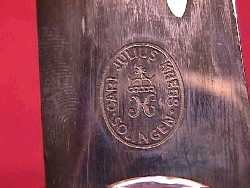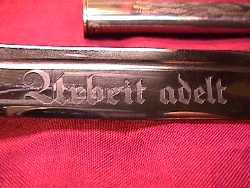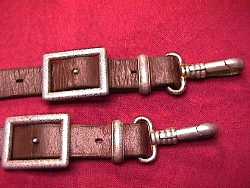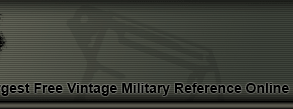
WWII GERMAN DAGGER - RAD LEADER'S HEWER
The German economy went through a depression during the early 1930's. The German government
created an organization called the
RAD to boost the economy through employment
generated by the inception of massive public works projects. As a result of such effort the
German infrastructure was rebuilt producing things such as the Autobahn.
It is about this time that Hitler had launched an expansion of the armed forces. Service in the
military was deemed mandatory. The RAD was employed as a means to breach the time between
graduating from school to entering military service.
Service in the RAD included military style drills such as marching, obeying orders, etc.
It was 1934 when all members of the organization were authorized to wear a dagger. However, in 1937
a new dagger was introduced to be worn by the RAD leaders. That dagger is featured on this page.


The handle of the RAD leader dagger is of very interesting design. It blends silver metal with
cream color inserts. The base of the handle is tapered and has a ring format. The pommel
consists of an eagle head with a well defined beak and eyes.
The back of the handle shows where the material has been chipped. The picture to the right
illustrates that a single screw is employed to secure the handle to the tang. Notice that the
screw configuration is the correct type where the screw fixing is not present on the obverse
side of the handle.
The handguard has a rolled shape on each side. The RAD emblem has been placed at the center
point. Consisting of a shovel head pointing upwards. A swastika is displayed in the middle of
the head. A wheat spear is placed on each side.


|
The information presented here includes high detail photos and descriptions that create an
identification guide for the RAD Leader's daggers. Additional information include a
pricing guide, which reflects the value of the daggers in the collector's market. This
data is very valuable to anyone wanting to expand their knowledge in the subject.
All this data is provided free of charge courtesy of
MilitaryItems.com, an organization who
provides a wide array of high quality military antiques and collectibles to museums,
state organizations and the general public. Our offering includes an on-line store with
over 3,000 items listed and more inventory added every day.
|
|

|
THE BLADE
The tip of the blade is a very characteristic "bowie" style. However, unlike its counterpart,
the blade is not heavy duty enough to hold and edge. The blade is also not as thick or as
heavy as the subordinate hewer.
A blood groove has been placed in along the spine. However, it does not cover the entire length
of the blade. This groove was built in primarily for looks since the dagger was not a fighting
weapon.
Also present is the RAD's motto "Arbeit adelt" which translates to "Labor ennobles". The words
are placed on one side of the blade and it is written in large gothic letters.
The manufacturer's logo is clearly visible on the side of the blade. It consists of an oval
shape with a crown placed in the center. The letter
"N" is located just below and
|
is written
in gothic style. The name "Carl Julius Krens" follows the contour of the oval in the upper
portion. This is the name of the factory. The name "Solingen" is found in the bottom section.
This is the name of the town where the Nazi dagger was produced.
|
THE RAD DAGGER SCABBARD
The design of the scabbard is very elegant. It is all of silver metal construction. The front and
back show some pebbling except for the throat and tip sections. Also left smooth are the sides.
A Celtic swirl pattern that adorns the throat section. Just below that are engraved wheat spears
pointing at an angle to the left and right.
Two wire-type brackets are attached to the side of the scabbard. Their purpose is to secure
the hanger to the dagger.
The tip of the scabbard has a smooth surface. It has a couple of engraved wheat spears angled
upwardly.
THE RAD DAGGER HANGER
The RAD leader's dagger hanger is made of brown leather. The design consists of a three section
metal brace. One component is long and rectangular. The othe is just below it and is divided
in half. A leather strap is attched to each half.
A rectangular metal buckle is placed on each strap. This piece permitted the length of each
strap to be modified. The end of the strap has a metal clip.
The hanger had a reputation of breaking very easily due to the weight of the dagger. Therefore,
many RAD members opted not to use it. This action makes it possible to find examples in mint
condition such as the one featured here.
|


|
A closer view of the hardware for the hanger is shown in the following photograph. The main components
consist of two square buckles and two metal hooks that help secure the dagger to the belt of the uniform.
The hanger is a difficult component to obtain.


A second dagger was also produced. It was known as the
subordinate hewer. It was
issued to non-leader personnel.
This edge weapon is currently being
reproduced. It is becoming more difficult to be
able to tell the fake ones from the real ones because the quality of the reproductions is improving. The
collector must become familiarized with the construction style and materials employed in the manufacturing
of edge weapons. Attention to the details is critical in order to be able to determine the authenticity
of the item.
If you have an interest is seeing other edge weapons of the Third Reich, you can do so by going to our
WWII German Edge Weapons identification guide. Where
we cover blades from the Heer (Army), Navy (Kriegsmarine), Air Force (Luftwaffe) and other organizations.
|







